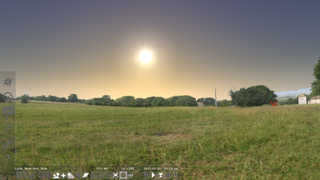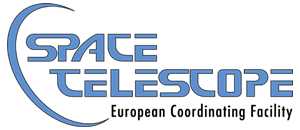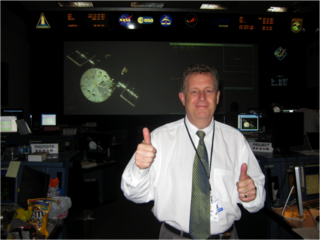
The European Organisation for Astronomical Research in the Southern Hemisphere, commonly referred to as the European Southern Observatory (ESO), is a 16-nation intergovernmental research organisation for ground-based astronomy. Created in 1962, ESO has provided astronomers with state-of-the-art research facilities and access to the southern sky. The organisation employs about 730 staff members and receives annual member state contributions of approximately €162 million. Its observatories are located in northern Chile.

Stellarium is a free and open-source planetarium, licensed under the terms of the GNU General Public License version 2, available for Linux, Windows, and macOS. A port of Stellarium called Stellarium Mobile is available for Android, iOS, and Symbian as a paid version, being developed by Noctua Software. All versions use OpenGL to render a realistic projection of the night sky in real time.

The Atacama Large Millimeter/submillimeter Array (ALMA) is an astronomical interferometer of 66 radio telescopes in the Atacama Desert of northern Chile, which observe electromagnetic radiation at millimeter and submillimeter wavelengths. The array has been constructed on the 5,000 m (16,000 ft) elevation Chajnantor plateau - near the Llano de Chajnantor Observatory and the Atacama Pathfinder Experiment. This location was chosen for its high elevation and low humidity, factors which are crucial to reduce noise and decrease signal attenuation due to Earth's atmosphere. ALMA is expected to provide insight on star birth during the early Stelliferous era and detailed imaging of local star and planet formation.

The second most recent transit of Venus observed from Earth took place on 8 June 2004. The event received significant attention, since it was the first Venus transit after the invention of broadcast media. No human alive at the time had witnessed a previous Venus transit since that transit occurred on 6 December 1882 in the 19th century.

The Space Telescope – European Coordinating Facility (ST-ECF) was an institution which provided a number of support and service functions primarily for European observers of the NASA/ESA Hubble Space Telescope (HST). It was established in 1984 by the European Space Agency (ESA) and the European Southern Observatory (ESO), and was located at the ESO headquarters in Garching bei München, Germany. The ST-ECF ceased operations on 31 December 2010.

The Royal Observatory, Edinburgh (ROE) is an astronomical institution located on Blackford Hill in Edinburgh. The site is owned by the Science and Technology Facilities Council (STFC). The ROE comprises the UK Astronomy Technology Centre (UK ATC) of STFC, the Institute for Astronomy of the School of Physics and Astronomy of the University of Edinburgh, and the ROE Visitor Centre.
Catharine "Katy" D. Garmany is an astronomer with the National Optical Astronomy Observatory. She holds a B.S. (astrophysics), 1966 from Indiana University; and a M.A. (astrophysics), 1968, and Ph.D. (astronomy), 1971, from the University of Virginia. Catharine's main areas of research are massive stars, evolution and formation; astronomical education.

The International Year of Astronomy (IYA2009) was a year-long celebration of astronomy that took place in 2009 to coincide with the 400th anniversary of the first recorded astronomical observations with a telescope by Galileo Galilei and the publication of Johannes Kepler's Astronomia nova in the 17th century. The Year was declared by the 62nd General Assembly of the United Nations. A global scheme, laid out by the International Astronomical Union (IAU), was also endorsed by UNESCO, the UN body responsible for educational, scientific, and cultural matters.
The Grand Rapids Amateur Astronomical Association is an astronomy group located in Grand Rapids, Michigan. It was formed in 1955 by an enthusiastic group of individuals led by businessman James C. Veen, with a love of astronomy and science. Veen initially provided a meeting place in his office, but died in an automobile accident in 1958.
Europlanet is a network linking planetary scientists from across Europe. The aim of Europlanet is to promote collaboration and communication between partner institutions and to support missions to explore the Solar System.
The Escambia Amateur Astronomers Association (EAAA) is an amateur astronomy club in Northwest Florida.
Science outreach, also called Education and Public Outreach or simply public outreach, is an umbrella term for a variety of activities by research institutes, universities, and institutions such as science museums, aimed at promoting public awareness of science and making informal contributions to science education.

The Israeli Astronomical Association (IAA) is an Israeli nonprofit organization. Its purpose is to deepen and distribute the awareness for the field of astronomy among the Israeli public.
Fabien Chéreau is a French Research Engineer and computer programmer best known for authoring the planetarium software Stellarium, a free, open source astronomy software package which renders 3D photo-realistic skies in real time.

Chile can be considered astronomy's world capital. In 2011, Chile was home to 42% of the world's astronomical infrastructure consisting mostly of telescopes. In 2015 it expected to contain more than 50% of the global infrastructure by 2030. In the Atacama desert region of northern Chile, the skies are exceptionally clear and dry for more than 300 days a year. These conditions have attracted the world's scientific community to develop in the Atacama desert the most ambitious astronomical projects in the history of mankind.

Pieter Timotheus "Tim" de Zeeuw is a Dutch astronomer specializing in the formation, structure and dynamics of galaxies.

Charles Mattias ("Matt") Mountain is currently the President of the Association of Universities for Research in Astronomy which designs, builds, and operates telescopes and observatories for the National Science Foundation (NSF) and the National Aeronautics and Space Administration (NASA). AURA's NASA center is the Space Telescope Science Institute (STScI), responsible for the science mission for the Hubble Space Telescope, the science and operations for the James Webb Space Telescope, and the MAST data archive. AURA's NSF centers are Gemini Observatory, the National Optical Astronomy Observatory (NOAO), and the National Solar Observatory (NSO). Dr. Mountain and AURA are also responsible for the NSF construction projects: the Daniel K. Inouye Solar Telescope (DKIST) on Haleakalā, Hawaii and the Large Synoptic Survey Telescope (LSST) on Cerro Pachón in Chile.

Network for Astronomy School Education (NASE) is an International Astronomical Union (IAU) Working Group that works on Training Teachers for primary and secondary schools. In 2007, professor George K. Miley, IAU vice-president, invited Rosa M. Ros to begin exploring the idea of setting up an astronomy program to give primary and secondary school teachers a better preparation in this area of knowledge. The birth of NASE Group occurred when Rosa Maria Ros and Alexandre Costa were sent by UNESCO and IAU to give two courses in Peru and Ecuador in July 2009. Shortly after NASE was officially created on August 2009 during IAU's General Assembly at Rio de Janeiro. From there on more than 80 courses have been presented worldwide.

The ESO Supernova Planetarium & Visitor Centre is an astronomy centre located at the site of the European Southern Observatory (ESO) Headquarters in Garching bei München. It offers exhibitions, guided tours and planetarium shows that feature observations made by the telescopes of the European Southern Observatory.















